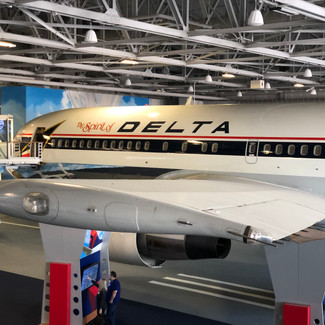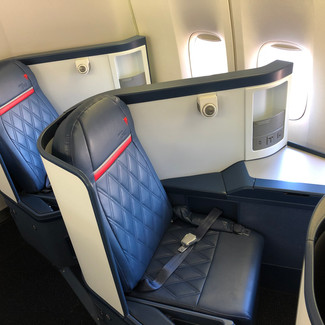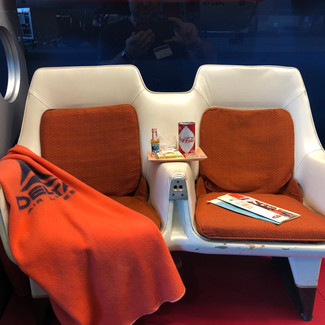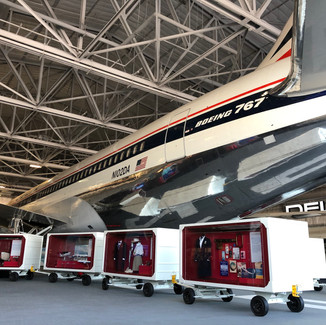Aviation: Delta Flight Museum review
- James White
- Dec 13, 2018
- 4 min read
Whilst on a visit to Atlanta, I took the opportunity to visit the Delta Air Lines flight museum adjacent to the airline’s headquarters at Atlanta Hartsfield Jackson Airport. The museum is situated in a former aircraft hangar and I was able to walk from a nearby hotel, but a few local buses were running around so access by public transport shouldn't be too difficult. Upon reaching to the complex I was asked for ID - I was able to gain entry with my UK driving licence. I was given a visitor’s badge that had to be worn at all times on the site. Personal items have to be put through an X-ray machine and visitors go through an airport style metal detector. Access cost a very reasonable $15.
The first exhibits focus on the early days of the airline, and an immaculate DC3 greets visitors along with other displays from the golden age of flying. Along the back wall of the building is a cinema showing videos covering the the airline’s formation, operations and experience. Next to this was an area with a selection of models, many of which seemed to be in bits, although a few were assembled.
Passing through to the second zone via a faux runway takes visitors into the jet age. Upon entering, you cant help but notice the centrepiece of the exhibition, Boeing 767-200 N102DA 'The Spirit of Delta', that flew for the airline between 1982 and 2006. It was purchased for the museum from donations made by Delta Air Lines employees. Heading around the hangar in a clockwise motion there are a pair of check in kiosks along the wall, followed by the tail section from one of the airlines DC9's. Next up is an exhibition covering the airline’s transition to a worldwide carrier, followed by the cockpit section of an early four-engined jet, a Convair CV-880. Along the back wall is a brief nod to the airline’s joint venture with Virgin Atlantic and a pair of jet engines - one is from a DC8. Carrying on round the 767, there were further exhibitions housed in cargo containers featuring previous uniforms, information on SkyTeam, another brief acknowledgement of Virgin Atlantic and a pair of First Class seats that were fitted to a Lockheed L-1011 Tristar. How things have changed over the last 20 years. There are also computer screens displaying a world map and featuring every Delta aircraft currently in the air, in what appears to be a mirror of that in the airline's operations centre. Along the back wall, there is a comparison of the first generation of premium cabin seating and the company’s current Delta One product, along with some information on the airline’s frequent flyer program.
Heading upstairs visitors reach a pair of flight simulators, the first being one from yesteryear and the second being a more current Boeing 737-200 simulator that can be hired for events. A walkway offers great view across the 767's wing and the rest of the hall. At its end is a L-1011 forward fuselage section that doubles up as a conference facility - this particular airframe was once the Lockheed-owned prototype and never operated for Delta, but has been repainted.
Next comes the entrance to the Boeing 767 cabin. Almost free reign to roam around the aircraft is possible, meaning some otherwise inaccessible areas can be reached. The 767 forward cabin section has been left more or less how it was when it was in service with a first class cabin up front, followed by few rows of economy seats. To the rear however there is a diorama of an airport, along with a few more items from the airline’s history including past uniforms.
That is pretty much it for the inside of the museum, however there’s more to be seen outside. This is reached through a gift shop stocked with Delta branded merchandise ranging from models, books and pens to rain jackets, t-shirts and postcards.
Across the car park are three more planes from the airline’s recent past, the crown jewel of which is the world’s first Boeing 747-400 that was acquired by Delta as part of the Northwest Airlines takeover in 2008. Of the three airliners outside the 747 was the only one accessible (via another security check) and much like the 767 inside, the forward section has been left intact and as it was in its flying days. Heading rearwards, visitors are able to step onto a platform on the wing, enabling some rather unique views. Inside, the floor in the rear section of the cabin has been replaced with Perspex offering an insight into what is below, and the ceiling has also been removed. It's only by seeing a 747 stripped back and void of any interior fittings that you get a true appreciation for the size of the aircraft.
Heading back out of the 747, a brief look around a Douglas DC9 parked alongside was possible although its doors were firmly shut. The third airliner is a Boeing 757 previously operated by Delta's low cost offshoot Song, but now repainted into the classic Delta Widget livery.
© James White 2018


































